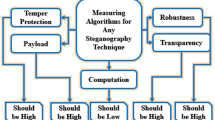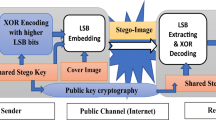Abstract
Presently, the design and development of an effective image steganography system are facing several challenges including the low capacity, poor robustness and imperceptibility. To surmount such limitations, it is important to improve the capacity and security of the steganography system while maintaining a high signal-to-noise ratio (PSNR). Based on these factors, this study is aimed to design and develop a distinction grade value (DGV) method to effectively embed the secret data into a cover image for achieving a robust steganography scheme. The design and implementation of the proposed scheme involved three phases. First, a new encryption method called the shuffle the segments of secret message (SSSM) was incorporated with an enhanced Huffman compression algorithm to improve the text security and payload capacity of the scheme. Second, the Fibonacci-based image transformation decomposition method was used to extend the pixel’s bit from 8 to 12 for improving the robustness of the scheme. Third, an improved embedding method was utilized by integrating a random block/pixel selection with the DGV and implicit secret key generation for enhancing the imperceptibility of the scheme. The performance of the proposed scheme is assessed experimentally to determine the imperceptibility, security, robustness and capacity. The resistance of the proposed scheme is tested against the statistical, χ2, Histogram and non-structural steganalysis detection attacks. The obtained PSNR values revealed the accomplishment of the higher imperceptibility and security by the proposed DGV scheme while maintaining higher capacity compared to the reported findings. In short, the proposed steganography scheme outperformed the commercially available data hiding schemes, thereby resolved the existing issues.



























Similar content being viewed by others
References
Abd El-Latif AA, Abd-El-Atty B, Hossain MS, Rahman MA, Alamri A, Gupta BB (2018) Efficient quantum information hiding for remote medical image sharing. IEEE Access 6:21075–21083
Abdulla AA (2015) Exploiting similarities between secret and cover images for improved embedding efficiency and security in digital steganography. Doctoral dissertation, University of Buckingham
Abdullatif FA, Abdullatif AA & al-Saffar A (2018) Hiding techniques for dynamic encryption text based on corner point. J Physics: Conf Series (Vol. 1003, no. 1, p. 012027). IOP Publishing
ALabaichi A, Al-Dabbas MAAAK, Salih A (2020) Image steganography using least significant bit and secret map techniques. Int J Electrical Comput Eng 10(1):2088–8708
Alam, S., Ahmad, T., & Doja, M. N. (2017). A novel edge based chaotic steganography method using neural network. In proceedings of the 5th international conference on Frontiers in intelligent computing: theory and applications (pp. 467–475). Springer, Singapore
Al-Husainy MAF, Uliyan DM (2019) A secret-key image steganography technique using random chain codes. Int J Technol 10(4):731–740
Al-Tamimi AGT, Alqobaty AA (2015) Image steganography using least significant bits (LSBs): a novel algorithm. Int J Comp Sci Inform Secur 13(1):1
Anushiadevi R, Praveenkumar P, Rayappan JBB, Amirtharajan R (2020) Reversible data hiding method based on pixel expansion and homomorphic encryption. Journal of Intelligent & Fuzzy Systems, (preprint), 1-14.
Arunkumar S, Subramaniyaswamy V, Vijayakumar V, Chilamkurti N, Logesh R (2019) SVD-based robust image steganographic scheme using RIWT and DCT for secure transmission of medical images. Measurement 139:426–437
Atawneh S, Almomani A, Al Bazar H, Sumari P, Gupta B (2017) Secure and imperceptible digital image steganographic algorithm based on diamond encoding in DWT domain. Multimed Tools Appl 76(18):18451–18472
Bower A, Insoft R, Li S, Miller SJ, Tosteson P (2015) The distribution of gaps between summands in generalized Zeckendorf decompositions. J Comb Theory, Series A 135:130–160
Fadhel S, Shafry M, Farook O (2017) Chaos image encryption methods: a survey study. Bull Electrical Eng Inform 6(1):99–104
Fadhil AM (2016). Bit inverting map method for improved steganography scheme. Diss. Universiti Teknologi Malaysia.
Gambhir A, & Arya R (2019) Performance analysis and implementation of DES algorithm and RSA algorithm with image and audio steganography techniques. In computing, communication and signal processing (pp. 1021–1028). Springer, Singapore
Grajeda-Marín IR, Montes-Venegas HA, Marcial-Romero JR, Hernández-Servín JA, Muñoz-Jiménez V, Luna GDI (2018) A new optimization strategy for solving the fall-off boundary value problem in pixel-value differencing steganography. Int J Pattern Recognit Artif Intell 32(01):1860010
Grajeda-Marín IR, Montes-Venegas HA, Marcial-Romero JR, Hernández-Servín JA, Muñoz-Jiménez V, Luna GDI (2018) A new optimization strategy for solving the fall-off boundary value problem in pixel-value differencing steganography. Int J Pattern Recognit Artif Intell 32(01):1860010
Gutub A, Al-Shaarani F (2020) Efficient implementation of multi-image secret hiding based on LSB and DWT steganography comparisons. Arab J Sci Eng 45(4):2631–2644
Hussain M, Wahab AWA, Idris YIB, Ho AT, Jung KH (2018) Image steganography in spatial domain: a survey. Signal Process Image Commun 65:46–66
Jouini L, Ouannas A, Khennaoui AA, Wang X, Grassi G, Pham VT (2019) The fractional form of a new three-dimensional generalized Hénon map. Adv Diff Equa 2019(1):1–12
Jumanto J (2018) An enhanced LSB-image steganography using the hybrid canny-Sobel edge detection. Cybern Inf Technol 18(2):74–88
Kadhim IJ, Premaratne P, Vial PJ, Halloran B (2019) Comprehensive survey of image steganography: techniques, evaluations, and trends in future research. Neurocomputing 335:299–326
Kadhim IJ, Premaratne P, Vial PJ (2020) High capacity adaptive image steganography with cover region selection using dual-tree complex wavelet transform. Cogn Syst Res 60:20–32
Kumar R, Singh H (2020) Recent trends in text steganography with experimental study, In handbook of computer networks and cyber security (pp. 849–872). Springer, Cham
Kumar V, Kumar D (2018) A modified DWT-based image steganography technique. Multimed Tools Appl 77(11):13279–13308
Kuo WC, Wang CC, Hou HC (2016) Signed digit data hiding scheme. Inf Process Lett 116(2):183–191
Laishram D, Tuithung T (2021) A novel minimal distortion-based edge adaptive image steganography scheme using local complexity. Multimed Tools Appl 80(1):831–854
Li D, Deng L, Gupta BB, Wang H, Choi C (2019) A novel CNN based security guaranteed image watermarking generation scenario for smart city applications. Inf Sci 479:432–447
Li J, Yu C, Gupta BB, Ren X (2018) Color image watermarking scheme based on quaternion Hadamard transform and Schur decomposition. Multimed Tools Appl 77(4):4545–4561
Liao X, Yu Y, Li B, Li Z, Qin Z (2019) A new payload partition strategy in color image steganography. IEEE Trans Circ Syst Video Technol 30(3):685–696
Luo X, Liu F, Yang C, Lian S, Zeng Y (2012) Steganalysis of adaptive image steganography in multiple gray code bit-planes. Multimed Tools Appl 57(3):651–667
Mahana SK, & Aggarwal RK (2019). Image steganography: Analysis & Evaluation of secret communication. In proceedings of international conference on sustainable computing in Science, Technology and Management (SUSCOM), Amity University Rajasthan, Jaipur-India.
Mukherjee N, Paul G, Saha SK, Burman D (2020) A PVD based high capacity steganography algorithm with embedding in non-sequential position. Multimed Tools Appl 1–31
Nayak R (2015) Steganography with BSS-RSA-LSB technique: a new approach to steganography. IJSEAT 3(5):187–190
Nguyen TD, Arch-Int S, Arch-Int N (2016) An adaptive multi bit-plane image steganography using block data-hiding. Multimed Tools Appl 75(14):8319–8345
Nikam VP, Dhande SS (2019) Extended Fibonacci series for selection of carrier samples in data hiding and extraction. In international conference on intelligent data communication technologies and internet of things (pp. 40-50). Springer, Cham.
Nisha CD, Monoth T (2020) Analysis of spatial domain image steganography based on pixel-value differencing method. In soft computing for problem solving (pp. 385–397). Springer, Singapore.
Nyeem H (2017) Reversible data hiding with image bit-plane slicing. In 2017 20th international conference of computer and information technology (ICCIT) (pp. 1-6). IEEE.
Pradhan A, Sekhar KR, Swain G (2018) Digital image steganography using LSB substitution, PVD, and EMD. Math Probl Eng 2018:1–11
Prasad S, & Pal AK (2019). Logistic map-based image steganography scheme using combined LSB and PVD for security enhancement. In emerging Technologies in Data Mining and Information Security (pp. 203–214). Springer, Singapore
Ramu P, Swaminathan R (2016) Imperceptibility—robustness tradeoff studies for ECG steganography using continuous ant colony optimization. Expert Syst Appl 49:123–135
Rao CS, Devi VB (2016) Comparative analysis of HVS based robust video watermarking scheme, In microelectronics, electromagnetics and telecommunications (pp. 103–110). Springer, New Delhi
Rawat R, Singh B, Sur A, Mitra P (2020) Steganalysis for clustering modification directions steganography. Multimed Tools Appl 79(3):1971–1986
Sahu AK, Swain G (2019) An optimal information hiding approach based on pixel value differencing and modulus function. Wirel Pers Commun 108(1):159–174
Saidi M, Hermassi H, Rhouma R, Belghith S (2017) A new adaptive image steganography scheme based on DCT and chaotic map. Multimed Tools Appl 76(11):13493–13510
Seyyedi SA, Sadau V, Ivanov N (2016) A secure steganography method based on integer lifting wavelet transform. IJ Network Security 18(1):124–132
Shanthakumari R, Malliga S (2020) Dual layer security of data using LSB inversion image steganography with elliptic curve cryptography encryption algorithm. Multimed Tools Appl 79(5):3975–3991
Som S, Mitra A, Palit S, Chaudhuri BB (2019) A selective bitplane image encryption scheme using chaotic maps. Multimed Tools Appl 78(8):10373–10400
Stojanovski T, Kocarev L (2001) Chaos-based random number generators-part I: analysis [cryptography]. IEEE Trans Circ Syst I: Fundamental Theory Appl 48(3):281–288
Subhedar MS, Mankar VH (2020) Secure image steganography using framelet transform and bidiagonal SVD. Multimed Tools Appl 79(3):1865–1886
Sun S (2016) A novel edge based image steganography with 2k correction and Huffman encoding. Inf Process Lett 116(2):93–99
Swain G (2018) High capacity image steganography using modified LSB substitution and PVD against pixel difference histogram analysis. Secur Commun Networks 2018:2018–2014
Swain G (2018) Adaptive and non-adaptive PVD steganography using overlapped pixel blocks. Arab J Sci Eng 43(12):7549–7562
Swain G (2019) Very high capacity image steganography technique using quotient value differencing and LSB substitution. Arab J Sci Eng 44(4):2995–3004
Thomas E (2015) The Fibonacci sequence through a different lens (doctoral dissertation)
Vikranth BM, Momin MH, Mohsin SM, Rimal S, Pandey SR (2015) A survey of image steganography. J Emerg Technol Innov Res 2(4)
Wu DC, Tsai WH (2003) A steganographic method for images by pixel-value differencing. Pattern Recogn Lett 24(9–10):1613–1626
Yang Y, Zhang W, Liang D, Yu N (2018) A ROI-based high capacity reversible data hiding scheme with contrast enhancement for medical images. Multimed Tools Appl 77(14):18043–18065
Yeung Y, Lu W, Xue Y, Chen J, Li R (2019) Secure binary image steganography based on LTP distortion minimization. Multimed Tools Appl. https://doi.org/10.1007/s11042-019-7731-0
Zodpe H, Sapkal A (2020) An efficient AES implementation using FPGA with enhanced security features. J King Saud Univ Eng Sci 32(2):115–122
Author information
Authors and Affiliations
Corresponding author
Additional information
Publisher’s note
Springer Nature remains neutral with regard to jurisdictional claims in published maps and institutional affiliations.
Rights and permissions
About this article
Cite this article
Taha, M.S., Rahem, M.S.M., Hashim, M.M. et al. High payload image steganography scheme with minimum distortion based on distinction grade value method. Multimed Tools Appl 81, 25913–25946 (2022). https://doi.org/10.1007/s11042-022-12691-9
Received:
Revised:
Accepted:
Published:
Issue Date:
DOI: https://doi.org/10.1007/s11042-022-12691-9




